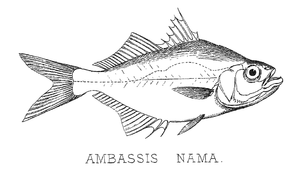Chanda nama
| Chanda nama | ||||||||||||
|---|---|---|---|---|---|---|---|---|---|---|---|---|

Chanda nama |
||||||||||||
| Systematics | ||||||||||||
|
||||||||||||
| Scientific name of the genus | ||||||||||||
| Chanda | ||||||||||||
| Hamilton , 1822 | ||||||||||||
| Scientific name of the species | ||||||||||||
| Chanda nama | ||||||||||||
| Hamilton, 1822 | ||||||||||||
Chanda nama ( Syn .: Ambassis nama ) is a freshwater and brackish water fish from the family of the glass perch (Ambassidae). It occurs in Pakistan , India , Nepal , Bangladesh and Burma .
features
It reaches a maximum length of 11 cm and has a body that is quite elongated for glass perches, which is strongly flattened at the sides and covered by tiny, sometimes irregularly arranged scales. The gap in the mouth is deep, the lower jaw protrudes. Chanda nama is transparent, shimmers green-yellow and is covered with numerous tiny black dots. They condense behind the gill cover to form a black line that runs from the beginning of the sideline down to above the base of the pectoral fin. The top of the head and the eyes are dark. The sideline is partly clearly visible, partly it is reduced. The unpaired fins of the males are orange, the upper edge of the first dorsal fin and the tip of the second black. The fins of the females are yellow. The two dorsal fins are almost completely separate.
- Fin formula : dorsal 1 VII, dorsal 2 I / 16-17, anal 11, ventral I / 5.
ecology
Chanda nama lives in standing and flowing water, in clear streams, canals, ponds and flooded rice fields. It is often during the rainy season , is loyal to its location and forms territory and feeds primarily on insect larvae, including the larvae of fever mosquitoes ( Anopheles ) and small crustaceans . They also eat the scales of other fish, especially during the rainy season. They can open their mouths at a 90 ° angle and have four conical, forward-pointing teeth in the elongated, protruding lower jaw, with which they tear the scales from the sides of their victims. Because of these adaptations to scale eating, the species was also placed in its own, monotypical genus. Molecular biological studies show, however, that the species belongs to the genus Parambassis .
swell
- Günther Sterba : The world's freshwater fish. 2nd Edition. Urania, Leipzig / Jena / Berlin 1990, ISBN 3-332-00109-4 .
- Archis R. Grubh, Kirk O. Winemiller: Ontogeny of Scale Feeding in the Asian Glassfish, Chanda nama (Ambassidae). In: Copeia . Vol. 2004, No. 4, 2004, pp. 903-907, doi : 10.1643 / CE-02-095R1 .
Individual evidence
- ↑ Chandani R. Verma, Pradeep Kumkar, Rajeev Raghavan, Unmesh Katwate, Mandar S. Paingankar, Neelesh Dahanukar: Glass in the water: Molecular phylogenetics and evolution of Indian glassy perchlets (Teleostei: Ambassidae). Journal of Zoological Systematics and Evolutionary Research, February 2019, doi: 10.1111 / jzs.12273 .
Web links
- Chanda nama on Fishbase.org (English)
- Chanda nama inthe IUCN Red List of Threatened Species 2013.2. Posted by: Dahanukar, N., 2010. Retrieved January 12, 2014.